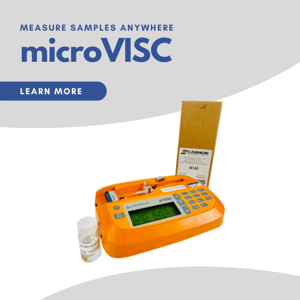
Thank You - Calculating Shear Rate: Easy-Peasy
Application Note
Calculating Shear Rate: Easy-Peasy
Key Words: Shear Rate, Product Development, Viscosity, Process Development, Quality Control, Characterization, Learning, Calculation, Fluid Mechanics, Fluids, Easy
Goal: Shear rates are the foundation of performing viscosity experiments. Viscometers determine viscosity by dividing shear stress experienced by the fluid by the shear rate. When developing novel fluids, their viscosity must be measured to characterize the fluid behavior for multiple environments. During the development and manufacturing process, fluids will experience different shear rates, which may also differ from the shear rates they experience in the hands of end users. So, knowing how to calculate shear rate is critical to performing experiments that will predict fluid viscosity outside the lab environment.
Introduction
Have you ever wondered what shear rate to use when you perform your viscosity measurements? Definitely. For any modern viscometer, whether it’s a parallel plate, cone and plate, or viscometer-rheometer on-a-chip (VROC®) system, knowing the shear rate or shear rate range to collect measurements is integral to quality control and product development. The next question you may have asked is: “did I choose the correct shear rate?” The answer to this question is murkier. You have a general idea of what shear rate to run, based on your previous experiences with your samples or products, and working with your colleagues. However, every sample is unique and a shear rate that works for one sample/application may not work well with another.
So, if you’ve ever wondered “how do I know the shear rate I use is right for my specific application?” Then, this application note is meant to help you make that determination. If you’re an experienced rheologist, then this note is meant to give you a quick refresher. Or if you’re simply just curious about fluid dynamics and viscosity, then it is meant to satisfy your curiosity.
Equations
The key information that you need to calculate shear rate is the velocity profile of the fluid and the derivative of this velocity profile. For many of RheoSense’s customers, fluid flow through a is the most common. For this type of flow, we need to know the volumetric flow rate, Q, and the cross-sectional area of the pipe the fluid is moving through to calculate shear rate. Some examples of fluids flowing through a circular cross-section include delivering drugs via a hypodermic needle or fluid flow through pipes. In these cases, we must make simplifying assumptions. We must assume that the flow is pressure driven, is fully enclosed, the flow rate or pressure drop is controlled, and that there is no slip at the boundary (r = R). The flow field characteristic of flow through a circular cross-section, which is characterized by the velocity profile of the fluid as function of radial position, is shown in figure 1.

To calculate the shear rate as a function of radius (r) use the below equation:

Solving this equation will allow you to predict the shear at different points of the flow field.
To calculate the maximum shear rate, or the shear rate at the boundary use this equation:

Remember to be consistent with your units! Here is in units of meters cubed per second and R is in meters.
We’ll be covering some common examples and debunk some myths in the next section.
The next type of shear environment we will be investigating is relative motion. We do need to make some simplifying assumptions just like in the circular cross-section case. Here we assume that the fluid is fully enclosed, that there is relative motion between the surfaces, the velocity of the surfaces is controlled, and that there is no slip at the boundaries. The flow field for this type of configuration is shown in figure 2.

At first glance, it might be hard to conceptualize the shear shown in figure 2, but it is something we see quite often. Relative motion shear is what we observe when we spread butter or jam on bread, when we rub lotion on our skin, when we spread paints and when we blink.
To calculate the shear rate of relative motion, use this equation:

Remember to keep units consistent! Velocity, , is meters per second and height, , is meters.
Examples
Now that we have the basic questions, we can estimate shear rates.
- What is the maximum shear rate through a 20-gauge (20G) needle of 1 mL of morphine injected in 10 seconds?
To answer this question, we need to know the inner diameter of the needle and we need to convert the flow rate: 1 mL in 10 seconds to meters cubed per second. A list of inner diameters for various needle gauges is summarized in table 1.
|
Gauge |
18 |
19 |
20 |
22 |
|
Inner Diameter (mm) |
0.838 |
0.686 |
0.603 |
0.413 |
Table 1. The inner diameter of hypodermic needles.
To convert from mL per second to meters cubed per second do the following unit conversion:
|
1 mL |
1 m3 |
|
10 seconds |
1 x 106 mL |
This conversion comes out to 1 x 10-7 m3 per second.
With the all the important parts of the equation known we can calculate the shear rate:

Some other flow rates that are used in delivering drugs are 0.2 mL per second and 0.067 mL per second (Watt et al). Try calculating the maximum shear rate through a hypodermic needle using these flow rates. Use table 1 as a reference for inner diameter of the needle.
- What is the relative motion shear rate of applying lotion between your moving hand and your stationary arm? Assume your hand is moving at 100 millimeters per second and the gap between your hand and your arm is 100 micrometers.
This shear rate is much easier to calculate. Make sure your units are correct and solve the equation for shear rate for relative motion.

Mythbusting!
Myth #1: A low flow rate means low shear rate.
A fluid flowing through a 22-gauge needle at 1 mL per minute has a maximum shear rate of 2410 s-1.
Myth #2: A High flow rate means a high shear rate.
A fluid flowing through a 300 mm pipe at 1L per minute has a maximum shear rate of 0.3773 s-1.
Recall the expression to calculate shear rate through a tube, , the shear rate of experienced by a fluid is much more heavily dependent on the radius of the tube than the flow rate, Q vs 1/R3.
Myth #3: Using a shear rate of 1000 s-1 or 3000 s-1 will accurately describe the shear environment a liquid drug will experience during delivery.
This chart summarizes the flow rates in mL per second for each of the needle gauges described in Table 1 assuming maximum shear rates of 1000 s-1 and 3000 s-1.
|
Shear Rates |
18 |
19 |
20 |
22 |
|
1000 s-1 |
0.058 mL/s |
0.032 mL/s |
0.022 mL/s |
0.007 mL/s |
|
3000 s-1 |
0.173 mL/s |
0.095 mL/s |
0.065 mL/s |
0.021 mL/s |
Remember that the flow rates used routinely in medical settings were 0.2 mL/s, 0.1 mL/s, and 0.067 mL/s (Watt et al). For many needle inner diameters, using a shear rate of 1000 or 3000 s-1 will not accurately represent the shear environment a drug will experience when injected. It is imperative that you calculate shear rate before conducting viscosity experiments so that you can correctly simulate the shear environment your fluids will experience during their use.
Concluding Remarks
Remember the shear rates calculated here are estimates for Newtonian fluids. For non-Newtonian fluids, estimating shear rate has a few more steps. However, the information provided here is a great starting point towards making more precise and relevant viscosity measurements. Accurately replicating the shear rates your products will experience during process or product development, quality control testing, and in the hands of the consumer will enable you to predict your fluids’ behavior in these environments. Quality viscosity measurements made earlier in the development process will yield better information about your fluids that will help you improve your product.
Reference
Watt Russell P., Khatri Hetal, Dibble Andrew R.G. (2019). Injectability as a function of viscosity and dosing materials for subcutaneous administration. International Journal of Pharmaceutics
If this note is helpful, please let us know! If you have questions or need more information about this product or other applications, please contact us:
Main Office — 1 925 866 3801
Sales – Sales@RheoSense.com
Information — info@RheoSense.com
.png?width=200&height=58&name=RheoSense%20Logo%20(REGISTERED).png)





-1.png?width=540&height=540&name=LNP%20m-VROC%20II%20App%20Note%20Tile%20(small)-1.png)


